Estimating the Past and Future Trajectory of LUCC on Wetland Ecosystem Service Values in the Yellow River Delta Region of China
Abstract
1. Introduction
2. Materials and Methods
2.1. Study Area
2.2. Data Collection and Preprocessing
2.3. Methods
2.3.1. Extent Dynamic of Land Utilization
2.3.2. Land Use Transfer Matrix
2.3.3. Assessment of Ecosystem Service Values (ESVs)
- Adjustment of ecosystem service equivalent factor
- 2.
- The determination of ecosystem service value onset per hectare
- 3.
- Calculation of ecosystem service values
2.3.4. Markov–FLUS Model
- Markov
- 2.
- FLUS model
2.3.5. Methods for Evaluating the Accuracy of Model Results
3. Results
3.1. Spatial–Temporal Changes in Land Use
3.2. Spatial and Temporal Characteristics of ESV in YRD from 2000 to 2020
3.3. Multi-Scenario Land Use Simulation
3.4. Characteristics of Changes in ESV under Multi-Scenarios
3.5. Hot Spot Assessment of ESV across Different Scenarios
4. Discussion
4.1. The Impact of Past and Future Trajectories of LUCC on ESVs in the YRD
4.2. Policy Implications and Suggestions on YRD
4.3. Limitations and Future Trends
5. Conclusions
Author Contributions
Funding
Data Availability Statement
Conflicts of Interest
Appendix A

| FES | SES | Cropland | Forest | Grassland | Water Body | Wetland | Artificial Surface | Bare Land |
|---|---|---|---|---|---|---|---|---|
| Support services | Food production | 0.85 | 0.23 | 0.23 | 0.80 | 0.51 | 0 | 0.00 |
| Raw material | 0.4 | 0.54 | 0.34 | 0.23 | 0.50 | 0 | 0 | |
| Water supply | 0.02 | 0.28 | 0.19 | 8.29 | 2.59 | 0 | 0.00 | |
| Regulation services | Air quality regulation | 0.67 | 1.76 | 1.21 | 0.77 | 1.90 | 0 | 0.02 |
| Climate regulation | 0.36 | 5.27 | 3.19 | 2.29 | 3.60 | 0 | 0.00 | |
| Waste treatment | 0.1 | 1.57 | 1.05 | 5.55 | 3.60 | 0 | 0.10 | |
| Regulation of water flows | 0.27 | 3.81 | 2.34 | 102.24 | 24.23 | 0 | 0.03 | |
| Supply services | Erosion prevention | 1.03 | 2.14 | 1.47 | 0.93 | 2.31 | 0 | 0.02 |
| Maintenance of soil fertility | 0.12 | 0.16 | 0.11 | 0.07 | 0.18 | 0 | 0.00 | |
| Habitat services | 0.13 | 1.95 | 1.34 | 2.55 | 7.87 | 0 | 0.02 | |
| Cultural services | Cultural services | 0.06 | 0.86 | 0.59 | 1.89 | 4.73 | 0 | 0.01 |
| FES | SES | Cropland | Forest | Grassland | Water Body | Wetland | Artificial Surface | Bare Land |
|---|---|---|---|---|---|---|---|---|
| Support services | Food production | 0.90 | 0.25 | 0.25 | 0.85 | 0.54 | 0.00 | 0.00 |
| Raw material | 0.42 | 0.57 | 0.36 | 0.24 | 0.53 | 0.00 | 0.00 | |
| Water supply | 0.02 | 0.29 | 0.20 | 8.79 | 2.75 | 0.00 | 0.00 | |
| Regulation services | Air quality regulation | 0.71 | 1.87 | 1.28 | 0.82 | 2.01 | 0.00 | 0.02 |
| Climate regulation | 0.38 | 5.58 | 3.38 | 2.43 | 3.82 | 0.00 | 0.00 | |
| Waste treatment | 0.11 | 1.66 | 1.12 | 5.88 | 3.82 | 0.00 | 0.11 | |
| Regulation of water flows | 0.29 | 4.04 | 2.48 | 108.37 | 25.68 | 0.00 | 0.03 | |
| Supply services | Erosion prevention | 1.09 | 2.27 | 1.56 | 0.99 | 2.45 | 0.00 | 0.02 |
| Maintenance of soil fertility | 0.13 | 0.17 | 0.12 | 0.07 | 0.19 | 0.00 | 0.00 | |
| Habitat services | 0.14 | 2.07 | 1.42 | 2.70 | 8.34 | 0.00 | 0.02 | |
| Cultural services | Cultural services | 0.06 | 0.91 | 0.63 | 2.00 | 5.01 | 0.00 | 0.01 |
| FES | SES | Cropland | Forest | Grassland | Water Body | Wetland | Artificial Surface | Bare Land |
|---|---|---|---|---|---|---|---|---|
| Support services | Food production | 1284.22 | 352.53 | 352.53 | 1208.68 | 770.53 | 0.00 | 0.00 |
| Raw material | 604.34 | 810.82 | 518.73 | 347.50 | 755.42 | 0.00 | 0.00 | |
| Water supply | 30.22 | 418.00 | 287.06 | 12,524.94 | 3913.10 | 0.00 | 0.00 | |
| Regulation services | Air quality regulation | 1012.27 | 2659.10 | 1823.09 | 1163.35 | 2870.61 | 0.00 | 30.22 |
| Climate regulation | 543.91 | 7957.14 | 4819.61 | 3459.85 | 5439.06 | 0.00 | 0.00 | |
| Waste treatment | 151.08 | 2367.00 | 1591.43 | 8385.22 | 5439.06 | 0.00 | 151.08 | |
| Regulation of water flows | 407.93 | 5756.34 | 3530.35 | 154,469.28 | 36,607.89 | 0.00 | 45.33 | |
| Supply services | Erosion prevention | 1556.18 | 3238.25 | 2220.95 | 1405.09 | 3490.06 | 0.00 | 30.22 |
| Maintenance of soil fertility | 181.30 | 246.77 | 171.23 | 105.76 | 271.95 | 0.00 | 0.00 | |
| Habitat services | 196.41 | 2951.19 | 2019.50 | 3852.67 | 11,890.39 | 0.00 | 30.22 | |
| Cultural services | Cultural services | 90.65 | 1294.29 | 891.40 | 2855.51 | 7146.32 | 0.00 | 15.11 |
| Artificial Surface | Cropland | Forest | Grassland | Bare Land | Water Body | Wetland | |
|---|---|---|---|---|---|---|---|
| 2020 | 61,447.37 | 453,630.25 | 0.36 | 1899.45 | 482.35 | 138,029.81 | 111,630.38 |
| ND | 70,376.58 | 431,099.46 | 0.27 | 1633.68 | 462.33 | 147,339.54 | 116,204.67 |
| CP | 61,578.27 | 455,051.79 | 0.27 | 1598.22 | 461.07 | 137,130.12 | 111,296.79 |
| UCD | 72,782.28 | 428,807.52 | 0.27 | 1631.16 | 462.24 | 147,288.51 | 116,144.55 |
| ED | 67,695.39 | 433,402.83 | 0.45 | 1638.99 | 460.71 | 147,511.89 | 116,406.27 |
| Cropland | Forest | Grassland | Water Body | Wetland | Artificial Surface | Bare Land | Total | |
|---|---|---|---|---|---|---|---|---|
| 2020 | 2748.32 | 0.01 | 34.62 | 26,195.00 | 8773.52 | 0.00 | 0.15 | 37,751.62 |
| ND | 2611.82 | 0.01 | 29.78 | 27,961.78 | 9133.04 | 0.00 | 0.14 | 39,736.56 |
| CP | 2756.93 | 0.01 | 29.13 | 26,024.26 | 8747.31 | 0.00 | 0.14 | 37,557.77 |
| UCD | 2597.93 | 0.01 | 29.73 | 27,952.10 | 9128.31 | 0.00 | 0.14 | 39,708.22 |
| ED | 2625.77 | 0.01 | 29.87 | 27,994.49 | 9148.88 | 0.00 | 0.14 | 39,799.17 |
References
- Sannigrahi, S.; Bhatt, S.; Rahmat, S.; Paul, S.K.; Sen, S. Estimating global ecosystem service values and its response to land surface dynamics during 1995–2015. J. Environ. Manag. 2018, 223, 115–131. [Google Scholar] [CrossRef] [PubMed]
- Xu, D.; Ding, X. Assessing the impact of desertification dynamics on regional ecosystem service value in North China from 1981 to 2010. Ecosyst. Serv. 2018, 30, 172–180. [Google Scholar] [CrossRef]
- Ding, T.; Chen, J.; Fang, Z.; Wang, Y. Exploring the differences of ecosystem service values in different functional areas of metropolitan areas. Sustain. Prod. Consump. 2023, 38, 341–355. [Google Scholar] [CrossRef]
- Liu, Z.; Wu, R.; Chen, Y.; Fang, C.; Wang, S. Factors of ecosystem service values in a fast-developing region in China: Insights from the joint impacts of human activities and natural conditions. J. Clean. Prod. 2021, 297, 126588. [Google Scholar] [CrossRef]
- Fu, H.; Yan, Y. Ecosystem service value assessment in downtown for implementing the “Mountain-River-Forest-Cropland-Lake-Grassland system project”. Ecol. Indic. 2023, 154, 110751. [Google Scholar] [CrossRef]
- Peng, K.; Jiang, W.; Wang, X.; Hou, P.; Wu, Z.; Cui, T. Evaluation of future wetland changes under optimal scenarios and land degradation neutrality analysis in the Guangdong-Hong Kong-Macao Greater Bay Area. Sci. Total. Environ. 2023, 879, 163111. [Google Scholar] [CrossRef] [PubMed]
- Zhu, L.; Ke, Y.; Hong, J.; Zhang, Y.; Pan, Y. Assessing degradation of lake wetlands in Bashang Plateau, China based on long-term time series Landsat images using wetland degradation index. Ecol. Indic. 2022, 139, 108903. [Google Scholar] [CrossRef]
- Zhu, L.; Zhu, K.; Zeng, X. Evolution of landscape pattern and response of ecosystem service value in international wetland cities: A case study of Nanchang City. Ecol. Indic. 2023, 155, 110987. [Google Scholar] [CrossRef]
- Chen, K.; Cong, P.; Qu, L.; Liang, S.; Sun, Z. Wetland degradation diagnosis and zoning based on the integrated degradation index method. Ocean Coasta. Manag. 2022, 222, 106135. [Google Scholar] [CrossRef]
- Zhu, X.; Jiao, L.; Wu, X.; Du, D.; Wu, J.; Zhang, P. Ecosystem health assessment and comparison of natural and constructed wetlands in the arid zone of northwest China. Ecol. Indic. 2023, 154, 110576. [Google Scholar] [CrossRef]
- Anley, M.A.; Minale, A.S.; Haregeweyn, N.; Gashaw, T. Assessing the impacts of land use/cover changes on ecosystem service values in Rib watershed, Upper Blue Nile Basin, Ethiopia. Trees For. People 2022, 7, 100212. [Google Scholar] [CrossRef]
- Xin, X.; Zhang, T.; He, F.; Zhang, W.; Chen, K. Assessing and simulating changes in ecosystem service value based on land use/cover change in coastal cities: A case study of Shanghai, China. Ocean Coast. Manag. 2023, 239, 106591. [Google Scholar] [CrossRef]
- Yin, Z.; Feng, Q.; Zhu, R.; Wang, L.; Chen, Z.; Fang, C.; Lu, R. Analysis and prediction of the impact of land use/cover change on ecosystem services value in Gansu province, China. Ecol. Indic. 2023, 154, 110868. [Google Scholar] [CrossRef]
- Rawat, L.S.; Maikhuri, R.K.; Bahuguna, Y.M.; Jugran, A.K.; Maletha, A.; Jha, N.K.; Phondani, P.C.; Dhyani, D.; Pharswan, D.S.; Chamoli, S. Rejuvenating ecosystem services through reclaiming degraded land for sustainable societal development: Implications for conservation and human wellbeing. Land Use Policy 2022, 112, 105804. [Google Scholar] [CrossRef]
- Cai, G.; Xiong, J.; Wen, L.; Weng, A.; Lin, Y.; Li, B. Predicting the ecosystem service values and constructing ecological security patterns in future changing land use patterns. Ecol. Indic. 2023, 154, 110787. [Google Scholar] [CrossRef]
- Cao, Y.; Kong, L.; Zhang, L.; Ouyang, Z. The balance between economic development and ecosystem service value in the process of land urbanization: A case study of China’s land urbanization from 2000 to 2015. Land Use Policy 2021, 108, 105536. [Google Scholar] [CrossRef]
- Rotich, B.; Kindu, M.; Kipkulei, H.; Kibet, S.; Ojwang, D. Impact of land use/land cover changes on ecosystem service values in the cherangany hills water tower, Kenya. Environ. Chall. 2022, 8, 100576. [Google Scholar] [CrossRef]
- Wei, F.; Xiang, M.; Deng, L.; Wang, Y.; Li, W.; Yang, S.; Wu, Z. Spatiotemporal Distribution Characteristics and Their Driving Forces of Ecological Service Value in Transitional Geospace: A Case Study in the Upper Reaches of the Minjiang River, China. Sustainability 2023, 15, 14559. [Google Scholar] [CrossRef]
- Zhou, Y.; Chen, T.; Wang, J.; Xu, X. Analyzing the Factors Driving the Changes of Ecosystem Service Value in the Liangzi Lake Basin—A GeoDetector-Based Application. Sustainability 2023, 15, 15763. [Google Scholar] [CrossRef]
- Jiang, W.; Lü, Y.; Liu, Y.; Gao, W. Ecosystem service value of the Qinghai-Tibet Plateau significantly increased during 25 years. Ecosyst. Serv. 2020, 44, 101146. [Google Scholar] [CrossRef]
- Admasu, S.; Yeshitela, K.; Argaw, M. Impact of land use land cover changes on ecosystem service values in the Dire and Legedadi watersheds, central highlands of Ethiopia: Implication for landscape management decision making. Heliyon 2023, 9, e15352. [Google Scholar] [CrossRef] [PubMed]
- Molinero-Parejo, R.; Aguilera-Benavente, F.; Gómez-Delgado, M.; Shurupov, N. Combining a land parcel cellular automata (LP-CA) model with participatory approaches in the simulation of disruptive future scenarios of urban land use change. Comput. Environ. Urban 2023, 99, 101895. [Google Scholar] [CrossRef]
- Aniah, P.; Bawakyillenuo, S.; Codjoe, S.; Dzanku, F. Land use and land cover change detection and prediction based on CA-Markov chain in the savannah ecological zone of Ghana. Environ. Chall. 2023, 10, 100664. [Google Scholar] [CrossRef]
- Lin, W.; Sun, Y.; Nijhuis, S.; Wang, Z. Scenario-based flood risk assessment for urbanizing deltas using future land-use simulation (FLUS): Guangzhou Metropolitan Area as a case study. Sci. Total. Environ. 2020, 739, 139899. [Google Scholar] [CrossRef] [PubMed]
- Girma, R.; Fürst, C.; Moges, A. Land use land cover change modeling by integrating artificial neural network with cellular Automata-Markov chain model in Gidabo river basin, main Ethiopian rift. Environ. Chall. 2022, 6, 100419. [Google Scholar] [CrossRef]
- Ma, B.; Wang, X. What is the future of ecological space in Wuhan Metropolitan Area? A multi-scenario simulation based on Markov-FLUS. Ecol. Indic. 2022, 141, 109124. [Google Scholar] [CrossRef]
- Qiu, J.; Huang, T.; Yu, D. Evaluation and optimization of ecosystem services under different land use scenarios in a semiarid landscape mosaic. Ecol. Indic. 2022, 135, 108516. [Google Scholar] [CrossRef]
- Xie, G.; Zhang, C.; Zhen, L.; Zhang, L. Dynamic changes in the value of China’s ecosystem services. Ecosyst. Serv. 2017, 26, 146–154. [Google Scholar] [CrossRef]
- Lusardi, J.; Sunderland, T.J.; Crowe, A.; Jackson, B.M.; Jones, G. Can process-based modelling and economic valuation of ecosystem services inform land management policy at a catchment scale? Land Use Policy 2020, 96, 104636. [Google Scholar] [CrossRef]
- Pan, D.; Yan, H.; Han, T.; Sun, B.; Jiang, J.; Liu, X.; Li, X.; Wang, H. Evaluation of the service function value of grassland ecosystems in Gansu Province using the equivalence factor method. Pratacultural Sci. 2021, 338, 1860–1868. [Google Scholar]
- Su, K.; Wei, D.; Lin, W. Evaluation of ecosystem services value and its implications for policy making in China—A case study of Fujian province. Ecol. Indic. 2020, 108, 105752. [Google Scholar] [CrossRef]
- Wu, K.; Wang, D.; Lu, H.; Liu, G. Temporal and spatial heterogeneity of land use, urbanization, and ecosystem service value in China: A national-scale analysis. J. Clean. Prod. 2023, 418, 137911. [Google Scholar] [CrossRef]
- Yang, Y.; Wang, K.; Liu, D.; Zhao, X.; Fan, J. Effects of land-use conversions on the ecosystem services in the agro-pastoral ecotone of northern China. J. Clean. Prod. 2020, 249, 119360. [Google Scholar] [CrossRef]
- Zhao, Q.; Wen, Z.; Chen, S.; Ding, S.; Zhang, M. Quantifying Land Use/Land Cover and Landscape Pattern Changes and Impacts on Ecosystem Services. Int. J. Environ. Res. Public Health 2020, 17, 126. [Google Scholar] [CrossRef] [PubMed]
- Hu, Z.; Gong, J.; Li, J.; Li, R.; Zhang, Z.; Zhong, F.; Wen, C. Valuing the coordinated development of urbanization and ecosystem service value in border counties. J. Clean. Prod. 2023, 415, 137799. [Google Scholar] [CrossRef]
- Tan, Z.; Guan, Q.; Lin, J.; Yang, L.; Luo, H.; Ma, Y.; Tian, J.; Wang, Q.; Wang, N. The response and simulation of ecosystem services value to land use/land cover in an oasis, Northwest China. Ecol. Indic. 2020, 118, 106711. [Google Scholar] [CrossRef]
- Zhang, X.; Zheng, Z.; Sun, S.; Wen, Y.; Chen, H. Study on the driving factors of ecosystem service value under the dual influence of natural environment and human activities. J. Clean. Prod. 2023, 420, 138408. [Google Scholar] [CrossRef]
- Wang, C.; Wang, Y.; Wang, R.; Zheng, P. Modeling and evaluating land-use/land-cover change for urban planning and sustainability: A case study of Dongying city, China. J. Clean. Prod. 2018, 172, 1529–1534. [Google Scholar] [CrossRef]
- Zheng, X.; Javed, Z.; Liu, C.; Tanvir, A.; Sandhu, O.; Liu, H.; Ji, X.; Xing, C.; Lin, H.; Du, D. MAX-DOAS and in-situ measurements of aerosols and trace gases over Dongying, China: Insight into ozone formation sensitivity based on secondary HCHO. J. Environ. Sci. 2024, 135, 656–668. [Google Scholar] [CrossRef]
- Zhang, T.; Zhang, S.; Cao, Q.; Wang, H.; Li, Y. The spatiotemporal dynamics of ecosystem services bundles and the social-economic-ecological drivers in the Yellow River Delta region. Ecol. Indic. 2022, 135, 108573. [Google Scholar] [CrossRef]
- Madrigal-Martínez, S.; Puga-Calderón, R.J.; Castromonte-Miranda, J.; Cáceres, V.A. Mapping the benefits and the exchange values of provisioning ecosystem services using GIS and local ecological knowledge in a high-Andean community. Remote Sens. Appl. 2023, 30, 100971. [Google Scholar] [CrossRef]
- Zhang, X.; Liu, L.; Chen, X.; Gao, Y.; Xie, S.; Mi, J. GLC_FCS30: Global land-cover product with fine classification system at 30 m using time-series Landsat imagery. Earth Syst. Sci. Data 2021, 13, 2753–2776. [Google Scholar] [CrossRef]
- Redo, D.J.; Aide, T.; Clark, M.L.; Andrade-Núnez, M. Impacts of internal and external policies on land change in Uruguay, 2001–2009. Environ. Conserv. 2012, 39, 122–131. [Google Scholar] [CrossRef]
- He, N.; Zhou, Y.; Wang, L.; Li, Q.; Zuo, Q.; Liu, J. Spatiotemporal differentiation and the coupling analysis of ecosystem service value with land use change in Hubei Province, China. Ecol. Indic. 2022, 145, 109693. [Google Scholar] [CrossRef]
- Sun, X.; Li, S.; Zhai, X.; Wei, X.; Yan, C. Ecosystem changes revealed by land cover in the Three-River Headwaters Region of Qinghai, China (1990–2015). Res. Cold Arid Reg. 2023, 15, 85–91. [Google Scholar] [CrossRef]
- Belay, T.; Melese, T.; Senamaw, A. Impacts of land use and land cover change on ecosystem service values in the Afroalpine area of Guna Mountain, Northwest Ethiopia. Heliyon 2022, 8, e12246. [Google Scholar] [CrossRef]
- Pham, K.T.; Lin, T.H. Effects of urbanisation on ecosystem service values: A case study of Nha Trang, Vietnam. Land Use Policy 2023, 128, 106599. [Google Scholar] [CrossRef]
- Yu, Q.; Feng, C.; Shi, Y.; Guo, L. Spatiotemporal interaction between ecosystem services and urbanization in China: Incorporating the scarcity effects. J. Clean. Prod. 2021, 317, 128392. [Google Scholar] [CrossRef]
- Xie, G.; Zhang, C.; Zhang, L.; Chen, W.; Li, S. Improvement of the Evaluation Method for Ecosystem Service Value Based on Per Unit Area. J. Nat. Resour. 2015, 30, 1243–1254. [Google Scholar]
- Berhanu, Y.; Dalle, G.; Sintayehu, D.W.; Kelboro, G.; Nigussie, A. Land use/land cover dynamics driven changes in woody species diversity and ecosystem services value in tropical rainforest frontier: A 20-year history. Heliyon 2023, 9, e13711. [Google Scholar] [CrossRef]
- Asori, M.; Adu, P. Modeling the impact of the future state of land use land cover change patterns on land surface temperatures beyond the frontiers of greater Kumasi: A coupled cellular automaton (CA) and Markov chains approaches. Remote Sens. Appl. 2023, 29, 100908. [Google Scholar] [CrossRef]
- Liu, P.; Hu, Y.; Jia, W. Land use optimization research based on FLUS model and ecosystem services–setting Jinan City as an example. Urban Clim. 2021, 40, 100984. [Google Scholar] [CrossRef]
- Chowdhury, M. Comparison of Accuracy and Reliability of Random Forest, Support Vector Machine, Artificial Neural Network and Maximum Likelihood method in Land use/cover Classification of Urban Setting. Environ. Chall. 2023, 14, 100800. [Google Scholar] [CrossRef]
- Xiao, Y.; Huang, M.; Xie, G.; Zhen, L. Evaluating the impacts of land use change on ecosystem service values under multiple scenarios in the Hunshandake region of China. Sci. Total Environ. 2022, 850, 158067. [Google Scholar] [CrossRef]
- Abera, W.; Tamene, L.; Kassawmar, T.; Mulatu, K.; Kassa, H.; Verchot, L.; Quintero, M. Impacts of land use and land cover dynamics on ecosystem services in the Yayo coffee forest biosphere reserve, southwestern Ethiopia. Ecosyst. Serv. 2021, 50, 101338. [Google Scholar] [CrossRef]
- Abd El-Hamid, H.T.; Toubar, M.M.; Zarzoura, F.; El-Alfy, M.A. Ecosystem services based on land use/cover and socio-economic factors in Lake Burullus, a Ramsar Site, Egypt. Remote Sens. Appl. 2023, 30, 100979. [Google Scholar] [CrossRef]
- Tolessa, T.; Kidane, M.; Bezie, A. Assessment of the linkages between ecosystem service provision and land use/land cover change in Fincha watershed, North-Western Ethiopia. Heliyon 2021, 7, e07673. [Google Scholar] [CrossRef] [PubMed]
- Xu, Y.; Xie, Y.; Wu, X.; Xie, Y.; Zhang, T.; Zou, Z.; Zhang, R.; Zhang, Z. Evaluating temporal-spatial variations of wetland ecosystem service value in China during 1990–2020 from the donor side based on cosmic exergy. J. Clean. Prod. 2023, 414, 137485. [Google Scholar] [CrossRef]
- Cai, Y.; Zhang, P.; Wang, Q.; Wu, Y.; Ding, Y.; Nabi, M.; Fu, C.; Wang, H.; Wang, Q. How does water diversion affect land use change and ecosystem service: A case study of Baiyangdian wetland, China. J. Environ. Manag. 2023, 344, 118558. [Google Scholar] [CrossRef]
- Sun, Z.; Mou, X.; Chen, X.; Wang, L.; Song, H. Actualities, problems and suggestions of wetland protection and restoration in the Yellow River Delta. Wetl. Sci. 2011, 9, 107–115. [Google Scholar]
- Fan, Y.; Chen, S.; Zhao, B.; Yu, S.; Ji, H.; Jiang, C. Monitoring tidal flat dynamics affected by human activities along an eroded coast in the Yellow River Delta, China. Environ. Monit. Assess. 2018, 190, 396. [Google Scholar] [CrossRef] [PubMed]
- Shi, Q.; Gu, C.; Xiao, C. Multiple scenarios analysis on land use simulation by coupling socioeconomic and ecological sustainability in Shanghai, China. Sustain. Cities Soc. 2023, 95, 104578. [Google Scholar] [CrossRef]
- Cao, Y. Forces driving changes in urban construction land of urban agglomerations in China. J. Urban Plan Dasce. 2015, 141, 05014011. [Google Scholar] [CrossRef]
- Sheng, X.; Cao, Y.; Zhou, W.; Zhang, H.; Song, L. Multiple scenario simulations of land use changes and countermeasures for collaborative development mode in Chaobai River region of Jing-Jin-Ji, China. Habitat Int. 2018, 82, 38–47. [Google Scholar] [CrossRef]
- Zhang, Y.; Yu, P.; Tian, Y.; Chen, H.; Chen, Y. Exploring the impact of integrated spatial function zones on land use dynamics and ecosystem services tradeoffs based on a future land use simulation (FLUS) model. Ecol. Indic. 2023, 150, 110246. [Google Scholar] [CrossRef]
- Yan, J.; Zhu, J.; Zhao, S.; Su, F. Coastal wetland degradation and ecosystem service value change in the Yellow River Delta, China. Glob. Ecol. Conserv. 2023, 44, e02501. [Google Scholar] [CrossRef]
- Long, X.; Lin, H.; An, X.; Chen, S.; Qi, S.; Zhang, M. Evaluation and analysis of ecosystem service value based on land use/cover change in Dongting Lake wetland. Ecol. Indic. 2022, 136, 108619. [Google Scholar] [CrossRef]
- Zeng, Q.; Ye, X.; Cao, Y.; Chuai, X.; Xu, H. Impact of expanded built-up land on ecosystem service value by considering regional interactions. Ecol. Indic. 2023, 153, 110397. [Google Scholar] [CrossRef]
- Zhai, Y.; Li, W.; Shi, S.; Gao, Y.; Chen, Y.; Ding, Y. Spatio-temporal dynamics of ecosystem service values in China’s Northeast Tiger-Leopard National Park from 2005 to 2020: Evidence from environmental factors and land use/land cover changes. Ecol. Indic. 2023, 155, 110734. [Google Scholar] [CrossRef]
- Wang, Y.; Zhang, Z.; Chen, X. Spatiotemporal change in ecosystem service value in response to land use change in Guizhou Province, southwest China. Ecol. Indic. 2022, 144, 109514. [Google Scholar] [CrossRef]
- Sun, X.; Li, Y.; Zhu, X.; Cao, K.; Feng, L. Integrative assessment and management implications on ecosystem services loss of coastal wetlands due to reclamation. J. Clean Prod. 2017, 163, S101–S112. [Google Scholar] [CrossRef]
- Pan, N.; Guan, Q.; Wang, Q.; Sun, Y.; Li, H.; Ma, Y. Spatial Differentiation and Driving Mechanisms in Ecosystem Service Value of Arid Region: A case study in the middle and lower reaches of Shule River Basin, NW China. J. Clean Prod. 2021, 319, 128718. [Google Scholar] [CrossRef]
- Xiang, S.; Wang, Y.; Deng, H.; Yang, C.; Wang, Z.; Gao, M. Response and multi-scenario prediction of carbon storage to land use/cover change in the main urban area of Chongqing, China. Ecol. Indic. 2022, 142, 109205. [Google Scholar] [CrossRef]
- Wang, Q.; Guan, Q.; Lin, J.; Luo, H.; Tan, Z.; Ma, Y. Simulating land use/land cover change in an arid region with the coupling models. Ecol. Indic. 2021, 122, 107231. [Google Scholar] [CrossRef]
- Bell-James, J.; Foster, R.; Lovelock, C.E. Identifying priorities for reform to integrate coastal wetland ecosystem services into law and policy. Environ. Sci. Policy 2023, 142, 164–172. [Google Scholar] [CrossRef]
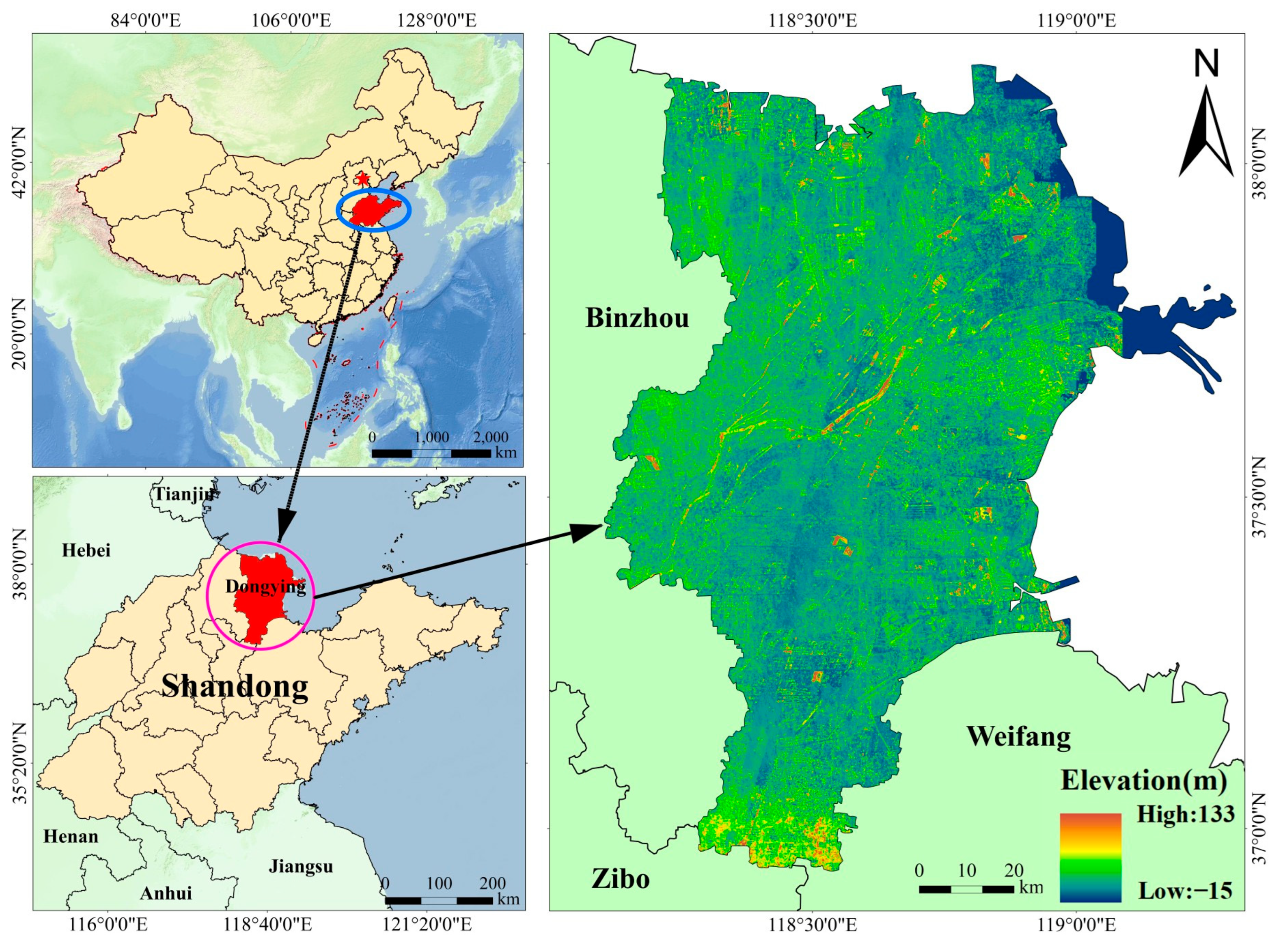
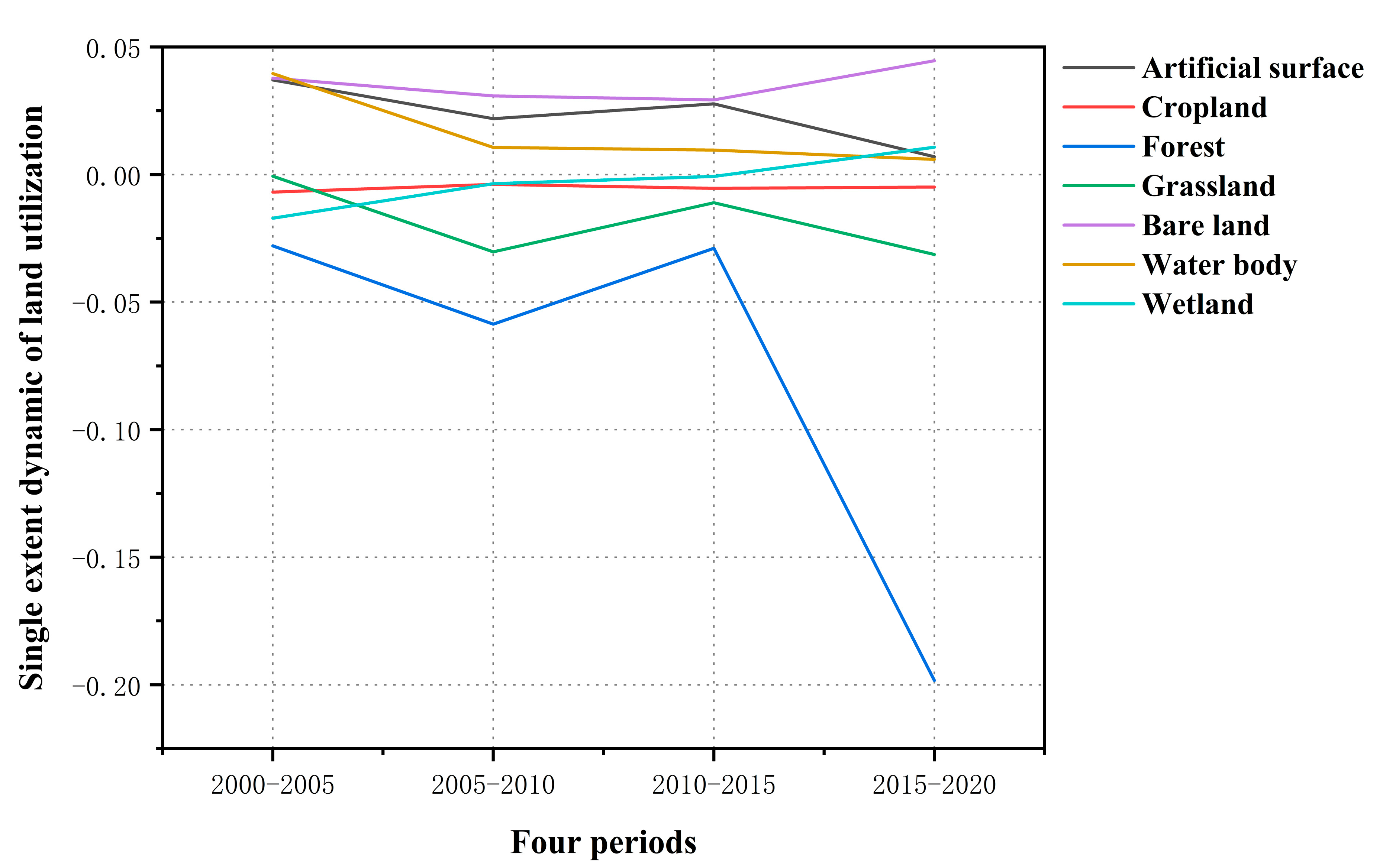
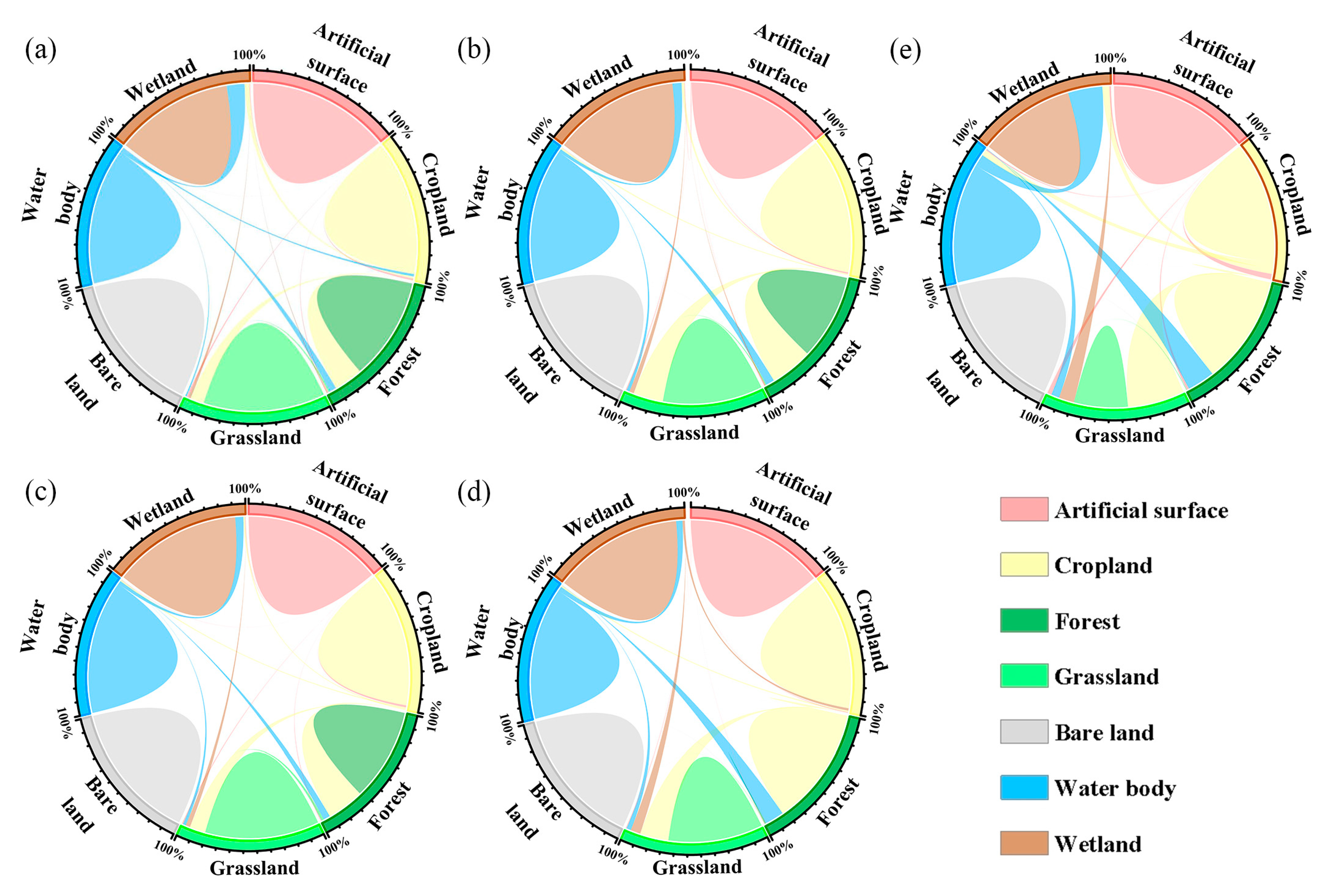
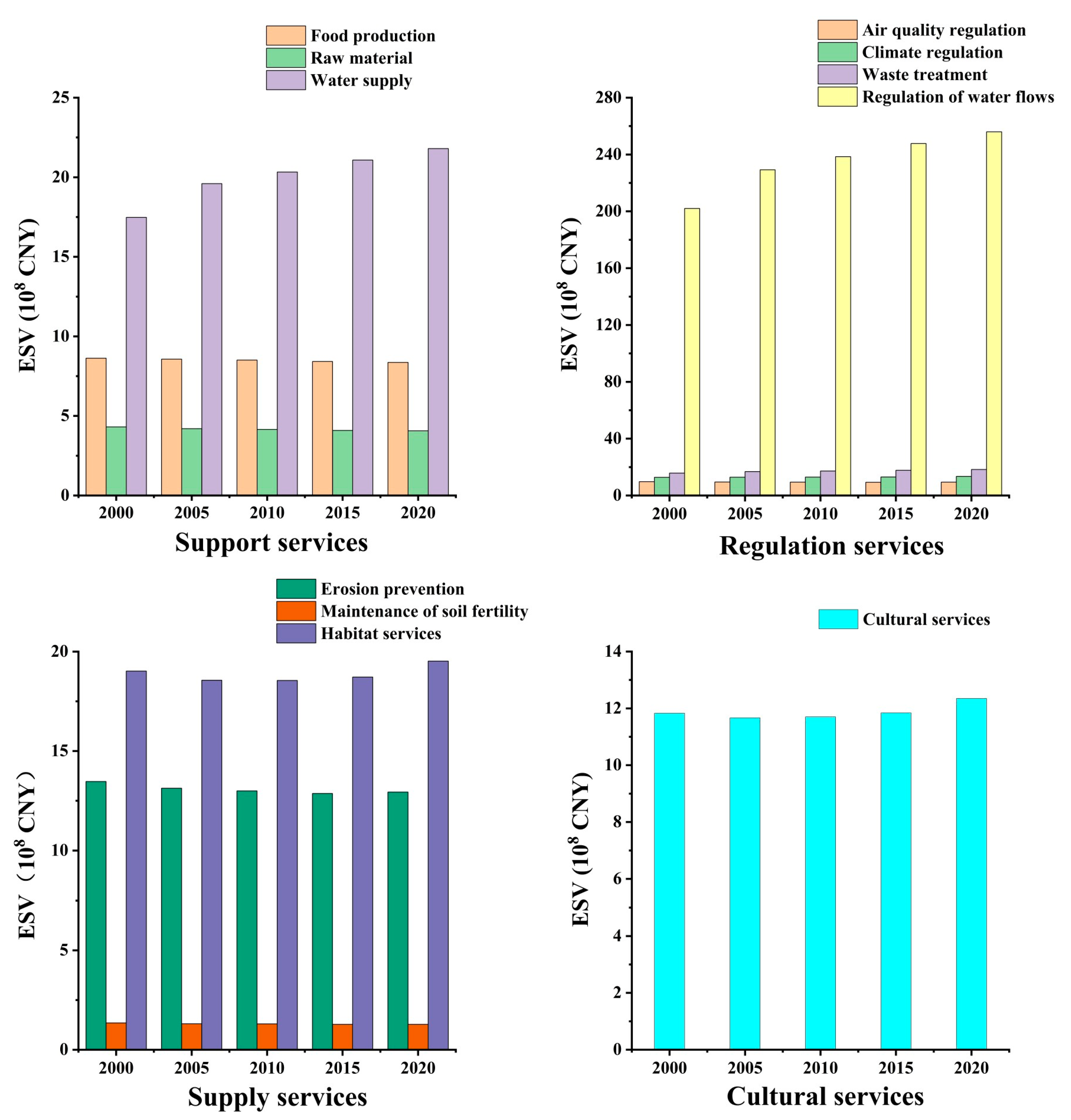
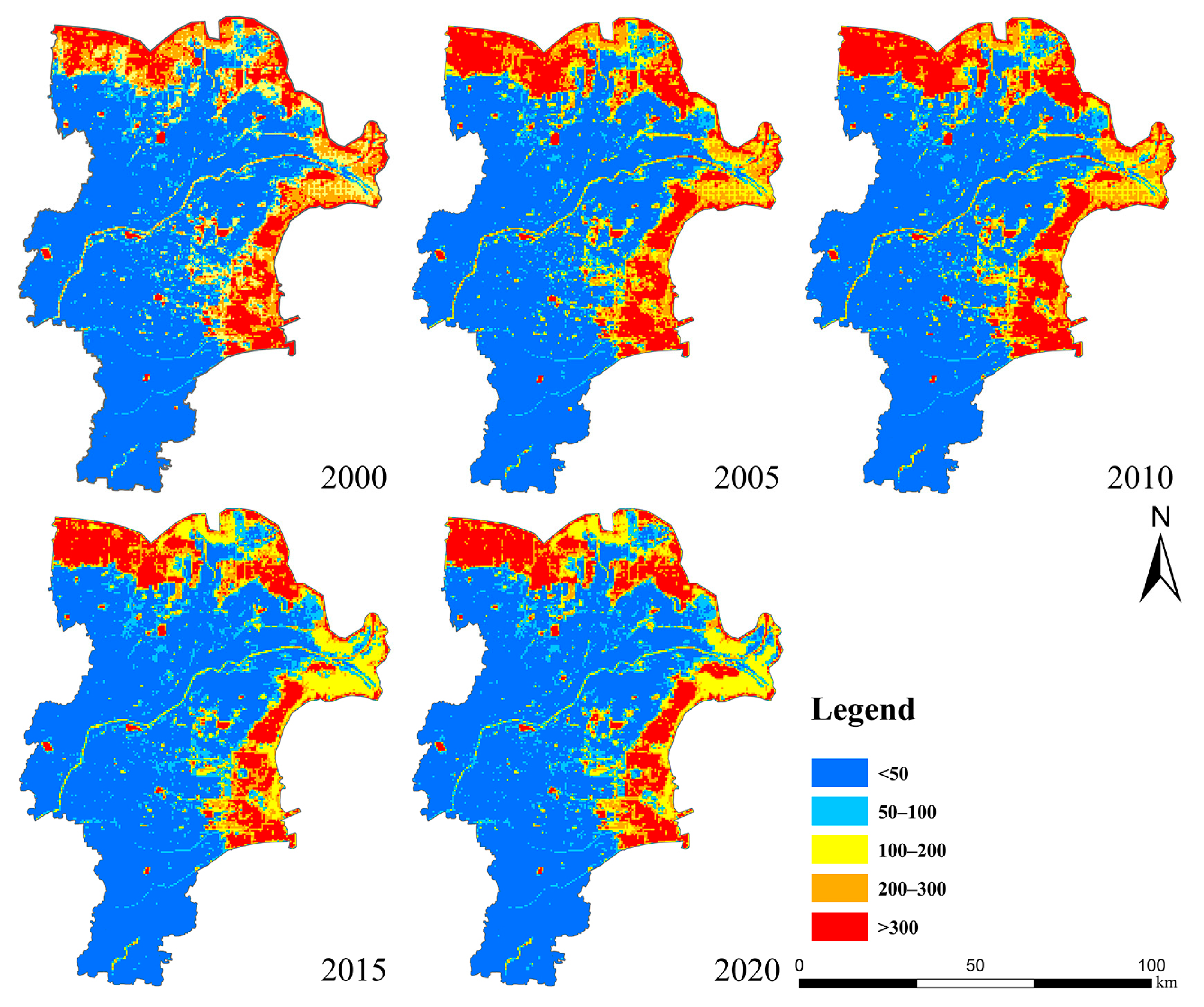
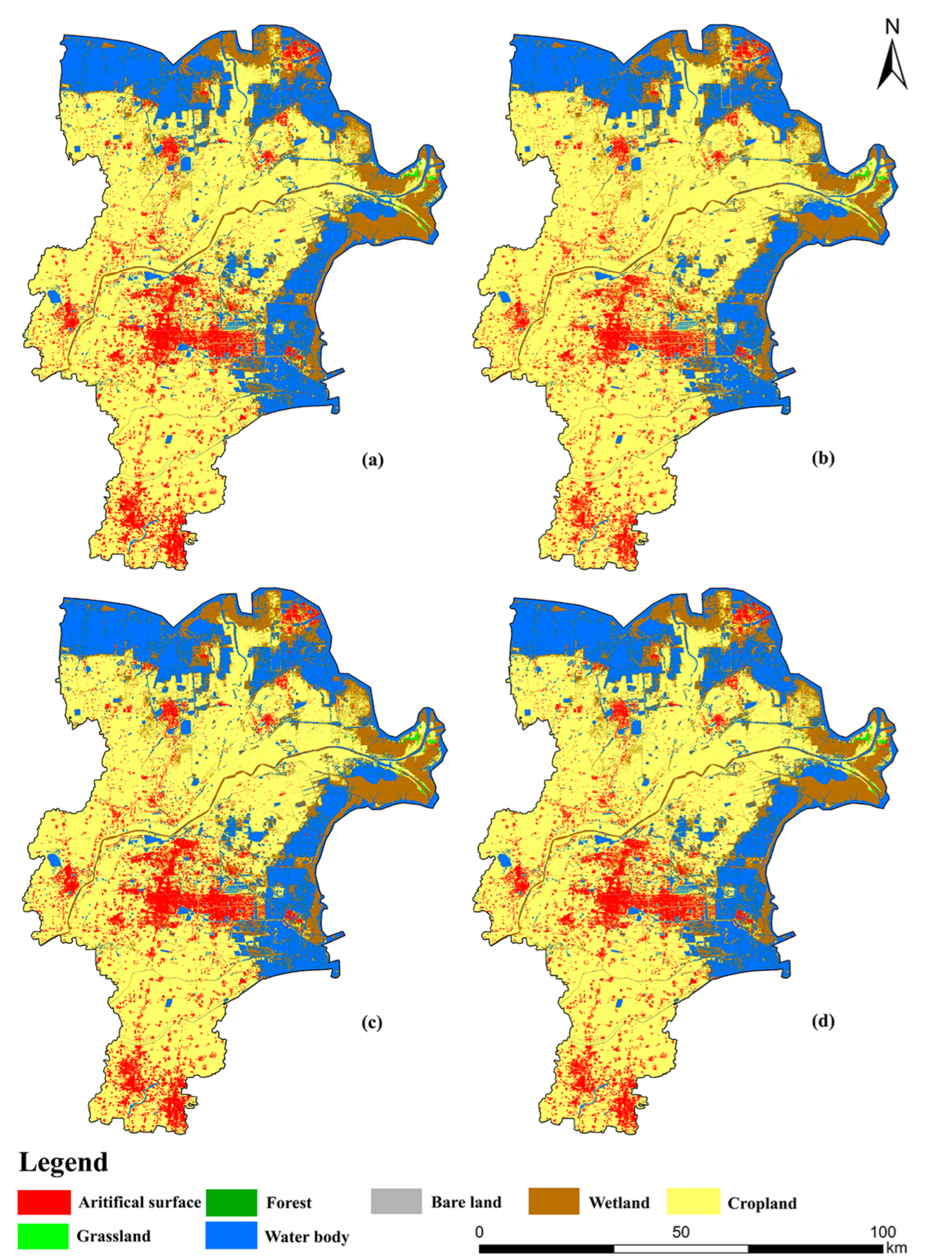
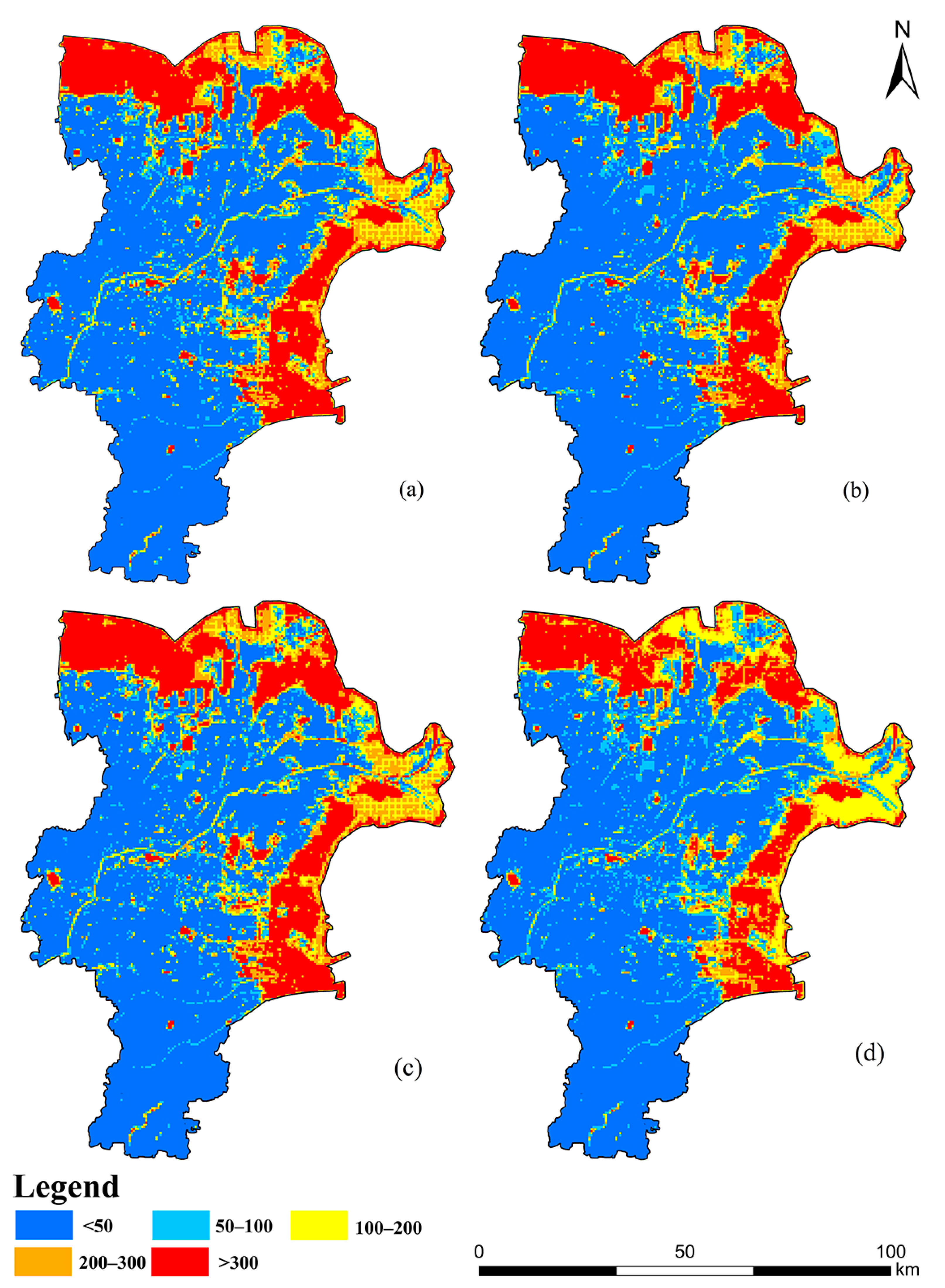
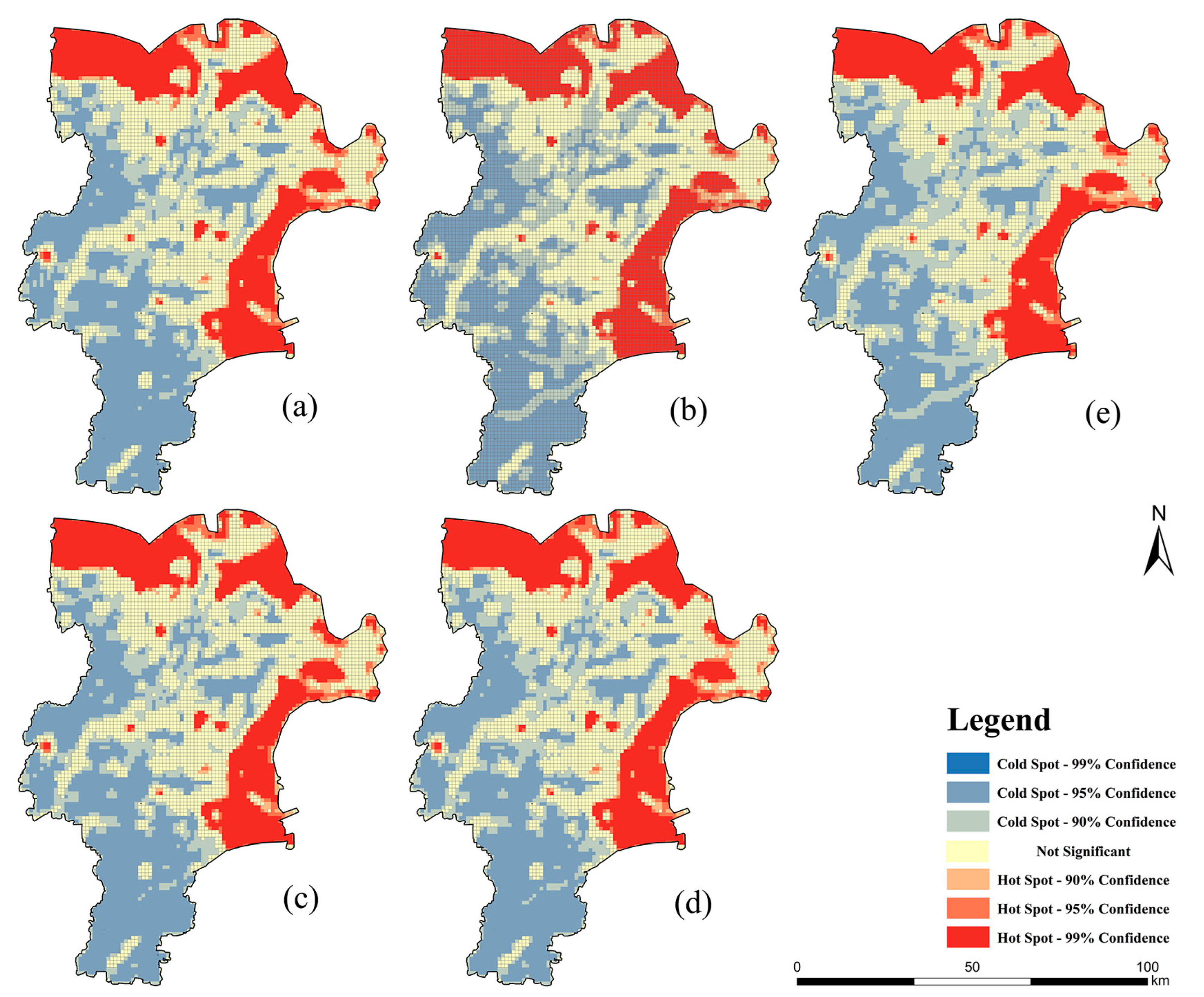
| 2000 | 2005 | 2010 | 2015 | 2020 | ||||||
|---|---|---|---|---|---|---|---|---|---|---|
| Area /ha | Proportion/% | Area /ha | Proportion/% | Area /ha | Proportion/% | Area /ha | Proportion/% | Area /ha | Proportion/% | |
| Artificial surface | 39,649.27 | 5.17 | 47,000.02 | 6.13 | 52,139.22 | 6.80 | 59,369.23 | 7.74 | 61,447.37 | 8.01 |
| Cropland | 504,680.14 | 65.79 | 487,304.23 | 63.52 | 478,055.59 | 62.32 | 465,109.30 | 60.63 | 453,630.25 | 59.13 |
| Forest | 79.26 | 0.01 | 68.19 | 0.01 | 48.22 | 0.01 | 41.26 | 0.01 | 0.36 | 0.00 |
| Grassland | 2817.72 | 0.37 | 2808.93 | 0.37 | 2383.19 | 0.31 | 2251.59 | 0.29 | 1899.45 | 0.25 |
| Bare land | 250.71 | 0.03 | 298.07 | 0.04 | 343.99 | 0.04 | 394.37 | 0.05 | 482.35 | 0.06 |
| Water body | 101,338.46 | 13.21 | 121,427.69 | 15.83 | 127,864.81 | 16.67 | 134,012.87 | 17.47 | 138,029.81 | 17.99 |
| Wetland | 118,310.28 | 15.42 | 108,216.64 | 14.11 | 106,287.81 | 13.86 | 105,941.78 | 13.81 | 111,630.38 | 14.55 |
| Cropland | Forest | Grassland | Water Body | Wetland | Artificial Surface | Bare Land | Total | ||
|---|---|---|---|---|---|---|---|---|---|
| 2000 | ESV/109 CNY | 3.06 | 0.00220 | 0.051 | 19.23 | 9.30 | 0.00 | 0.00008 | 31.64 |
| Proportion/% | 9.66 | 0.01000 | 0.160 | 60.78 | 29.39 | 0.00 | 0.00024 | 100.00 | |
| 2005 | ESV/109 CNY | 2.95 | 0.00190 | 0.051 | 23.04 | 8.51 | 0.00 | 0.00009 | 34.56 |
| Proportion/% | 8.54 | 0.01000 | 0.150 | 66.69 | 24.61 | 0.00 | 0.00026 | 100.00 | |
| 2010 | ESV/109 CNY | 2.90 | 0.00140 | 0.043 | 24.27 | 8.35 | 0.00 | 0.00010 | 35.56 |
| Proportion/% | 8.14 | 0.00400 | 0.120 | 68.24 | 23.49 | 0.00 | 0.00029 | 100.00 | |
| 2015 | ESV/109 CNY | 2.81 | 0.00120 | 0.041 | 25.43 | 8.33 | 0.00 | 0.00012 | 36.62 |
| Proportion/% | 7.70 | 0.00300 | 0.110 | 69.45 | 22.74 | 0.00 | 0.00033 | 100.00 | |
| 2020 | ESV/109 CNY | 2.74 | 0.00001 | 0.035 | 26.19 | 8.77 | 0.00 | 0.00015 | 37.75 |
| Proportion/% | 7.28 | 0.00003 | 0.090 | 69.39 | 23.24 | 0.00 | 0.00039 | 100.00 |
Disclaimer/Publisher’s Note: The statements, opinions and data contained in all publications are solely those of the individual author(s) and contributor(s) and not of MDPI and/or the editor(s). MDPI and/or the editor(s) disclaim responsibility for any injury to people or property resulting from any ideas, methods, instructions or products referred to in the content. |
© 2024 by the authors. Licensee MDPI, Basel, Switzerland. This article is an open access article distributed under the terms and conditions of the Creative Commons Attribution (CC BY) license (https://creativecommons.org/licenses/by/4.0/).
Share and Cite
Zhang, Z.; Han, L.; Feng, Z.; Zhou, J.; Wang, S.; Wang, X.; Fan, J. Estimating the Past and Future Trajectory of LUCC on Wetland Ecosystem Service Values in the Yellow River Delta Region of China. Sustainability 2024, 16, 619. https://doi.org/10.3390/su16020619
Zhang Z, Han L, Feng Z, Zhou J, Wang S, Wang X, Fan J. Estimating the Past and Future Trajectory of LUCC on Wetland Ecosystem Service Values in the Yellow River Delta Region of China. Sustainability. 2024; 16(2):619. https://doi.org/10.3390/su16020619
Chicago/Turabian StyleZhang, Zhiyi, Liusheng Han, Zhaohui Feng, Jian Zhou, Shengshuai Wang, Xiangyu Wang, and Junfu Fan. 2024. "Estimating the Past and Future Trajectory of LUCC on Wetland Ecosystem Service Values in the Yellow River Delta Region of China" Sustainability 16, no. 2: 619. https://doi.org/10.3390/su16020619
APA StyleZhang, Z., Han, L., Feng, Z., Zhou, J., Wang, S., Wang, X., & Fan, J. (2024). Estimating the Past and Future Trajectory of LUCC on Wetland Ecosystem Service Values in the Yellow River Delta Region of China. Sustainability, 16(2), 619. https://doi.org/10.3390/su16020619







